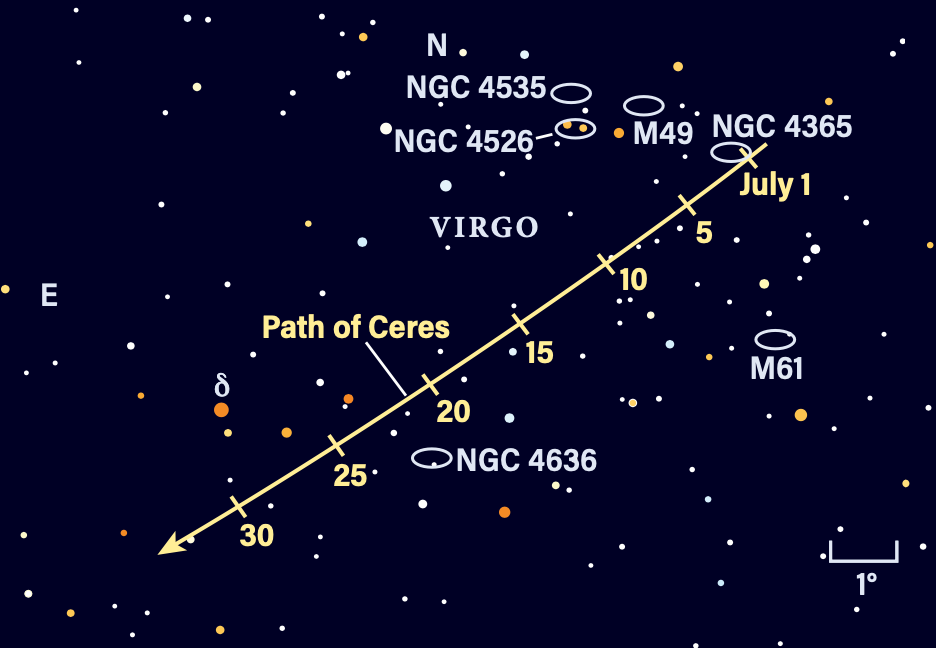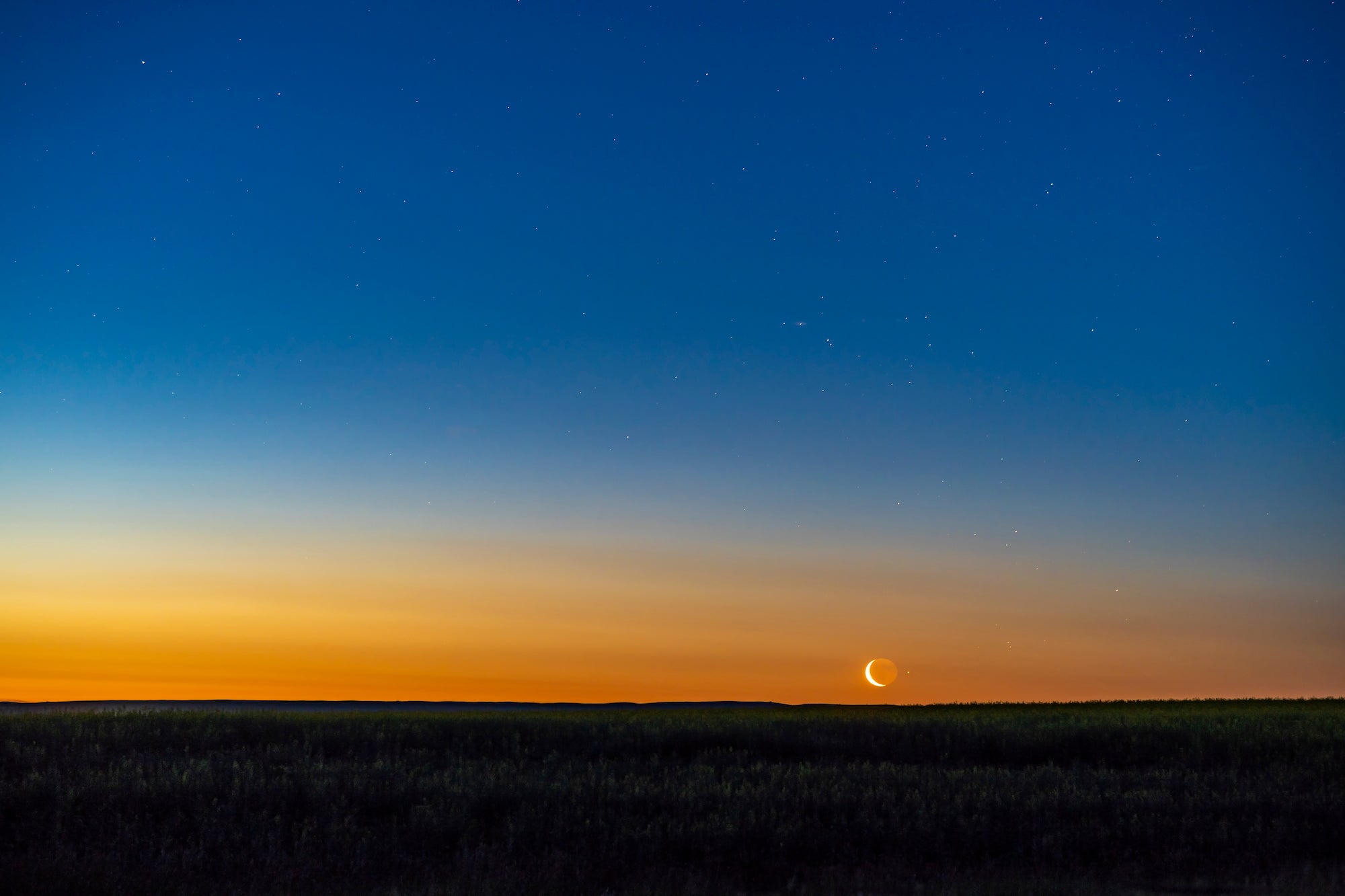
Mercury and Venus put on an evening show — try and spot them both soon after sunset during evenings in late July. Much fainter Mars also joins in. Set against Leo the Lion and its bright star Regulus, these three planets are the first objects to view this summer. The predawn sky is best for Saturn — which rises soon after sunset — and its giant neighbor Jupiter, appearing after midnight. You can also spot Uranus and Neptune in binoculars, both easy catches for an early-morning observing run.
Starting in the evening sky, the two innermost planets of the solar system, Venus and Mercury, provide a good show in July. Summer nights are a perfect time for comfortable evening viewing, and these two targets don’t disappoint.
Venus reaches its greatest illuminated extent July 7, when its 26-percent-illuminated crescent shines at magnitude –4.7. It sets two hours after the Sun, so the brilliant planet remains in the western sky well into a dark evening. Throughout the month, a telescopic view shows the apparent size of Venus growing from 34″ to 54″.
Venus and Mars lie near each other against the backdrop of Leo. On July 1, Mars is 3.6° east of Venus and shines a much fainter magnitude 1.7. Regulus, at magnitude 1.4, is the brightest star in Leo and sits some 5° southeast of Mars. Both Mars and Venus move eastward and by July 9, Mars sits 45′ due north of Regulus. Venus stands 4.7° west of the pairing. Mars is a tiny 4″ across as it continues its slow journey on the far side of the solar system from Earth.
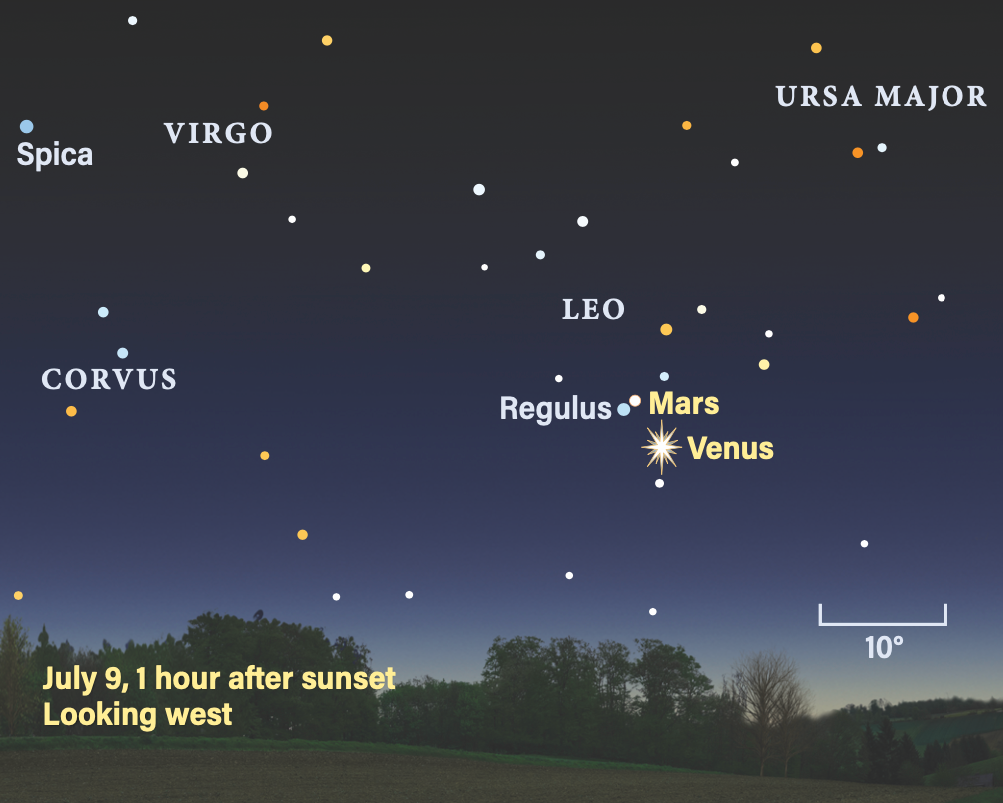
Venus continues eastward but never makes it to Regulus and instead begins to dip lower in the western sky. By July 20, a crescent Moon joins the beautiful twilight scene, standing 4.5° east of Regulus, while Venus lies 3.9° southwest of the star.
Mercury, meanwhile, stands 11.4° northwest of Venus on this date, shining at magnitude –0.4. Mercury remains up for an hour after sunset; this is a great evening to observe the nearest planet to the Sun.
Mercury makes quick progress east and stands 5.5° due north of Venus on July 25. Now at magnitude –0.1, the smaller planet is an easy object in twilight. Mars is now just over 12° east of Venus, and Leo’s Sickle asterism punctuates the fine evening scene as darkness falls.
On July 28, Mercury — at magnitude 0 — stands less than 10′ from Regulus. Catch it as soon as the sky darkens, as the pair sets an hour after the Sun and becomes very low quite quickly. By the end of July, Venus sets within 25 minutes of sunset, only allowing a short window to catch it. Mercury soon succumbs to twilight as well, with this apparition more favorably seen from the equator and Southern Hemisphere.
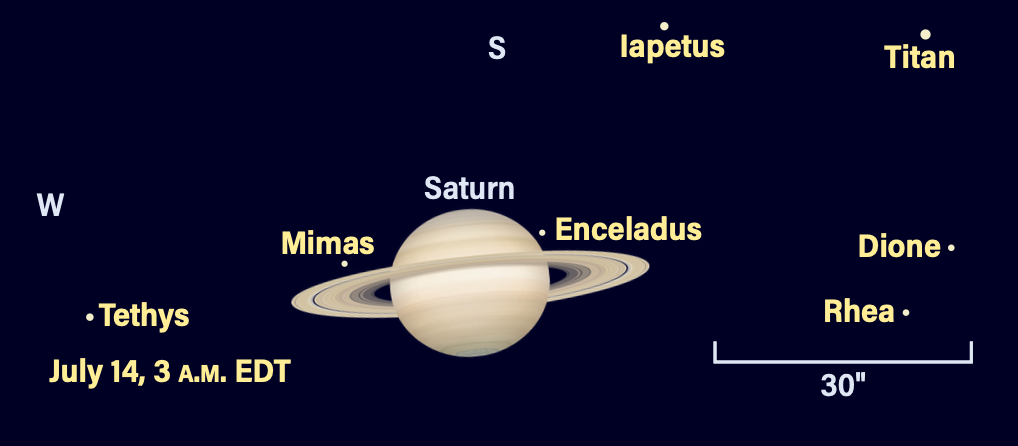
Saturn rises along with the stars of Aquarius the Water-bearer around 11:30 p.m. on July 1, and by a couple of hours earlier at the end of the month. It starts July at a respectable magnitude 0.7, brightening by 0.2 magnitude during the month and outshining the 1st-magnitude star Fomalhaut to its south in Piscis Austrinus. The planet is well placed for observation in the southern sky a few hours after midnight in late July.
Telescopic views of Saturn reveal its 18″-wide disk surrounded by the stunning ring system that spans more than double that width. The ring tilt reached a minimum for the year last month at 7.3°; it opens a little to 8.1° by July 31 as a result of Earth’s motion relative to Saturn’s orbital plane. More generally, the rings are narrowing to an edge-on view in 2025, but exhibit a small annual fluctuation as Earth rides around the Sun every year.
Saturn’s brightest moon, Titan, shines at magnitude 8.5. It stands north of the planet overnight on July 6/7 and 22/23, and south on July 14/15 and 30/31. Other moons are fainter and closer to the planet and rings, shining between 9th and 11th magnitude.
Iapetus reaches superior conjunction July 13. In early July, it is moving from its late June western elongation — when it was brightest — and getting closer to Saturn as it fades to 11th magnitude, a result of its darker hemisphere turning earthward. Usually far from Saturn, Iapetus passes a mere 36″ south of the planet on July 13, then on the following morning stands less than 30″ due west of Titan, offering an easy guide to spot this faint moon. Don’t confuse the moon with a magnitude 10.5 field star 1.5′ due west of Saturn and due north of Iapetus on July 11.
Try following Iapetus from night to night as it moves east of Saturn in the latter half of July. As it wanders farther from the planet, it become harder to identify. It reaches eastern elongation on the first day of August, when it stands 9′ from the planet and has faded by a magnitude.
Neptune rises shortly after midnight early in July and is well placed for viewing before dawn. It reaches a stationary point July 1 and then moves westward only one-third of a degree all month. It’s located 4.7° southeast of Lambda (λ) Piscium and shines at magnitude 7.7. This places it within reach of binoculars held with a steady pair of hands or, better yet, mounted on a solid tripod.
Two stars, 5th-magnitude 20 Piscium and 6th-magnitude 24 Piscium, lie south of Neptune’s path. The distant planet forms a triangle with the pair that changes shape slightly from night to night, reflecting Neptune’s motion against the background star field. Another star equaling Neptune’s glow and easy to mistake for the planet lies in the same region — Neptune is the northernmost object. A telescope under steady seeing conditions might render the tiny, bluish, 2″-wide disk visible.
It’s a short hop east to the next constellation along the ecliptic, Aries, which now contains Jupiter. The brilliant planet changes this region of sky significantly as it reaches magnitude –2.4 by the last day of July. A waning crescent Moon wanders past on July 11th and 12th. The gas giant rises at 2 a.m. on July 1 and just after local midnight on July 31. This places it some 35° high in the east as dawn begins. Jupiter moves 4° east during the month, ending July 12.5° southeast of Hamal, the brightest star in Aries.
Swing your scope toward Jupiter for great views of its dual dark equatorial belts, which carry spots around the planet in less than 10 hours. The world’s constantly changing appearance attracts observers and it’s a good time to get in on the action. The Great Red Spot appears occasionally if the right hemisphere is facing Earth. The stable air of early mornings can offer outstanding views that evening observations following the heat of the day rarely provide.
Joining Jupiter is its familiar retinue of four Galilean moons. These moons orbit with periods ranging from about two to 17 days. In addition to their changing relative positions, they also transit the face of Jupiter or are occulted by the planet’s disk. The observing window for these events is growing as Jupiter approaches opposition in a few months’ time.
Two events are noteworthy this month. On July 11, Io and its shadow transit the globe of Jupiter, starting with the moon’s shadow at 4:35 a.m. CDT, followed by Io itself at 4:51 a.m. CDT. Both track across Jupiter into the dawn sky.
Ganymede joins Io in the action July 19. First the larger moon transits Jupiter’s southern polar region starting at 3:23 a.m. EDT and ending over an hour later, at 3:55 a.m. CDT (note the time change — this is after sunrise on the East Coast). As the transit begins, notice Io off the northwest limb of Jupiter. Just minutes after Ganymede’s transit begins, the smaller moon enters the planet’s long shadow, which prior to opposition extends west of the planet, becoming eclipsed at 3:46 a.m. EDT.
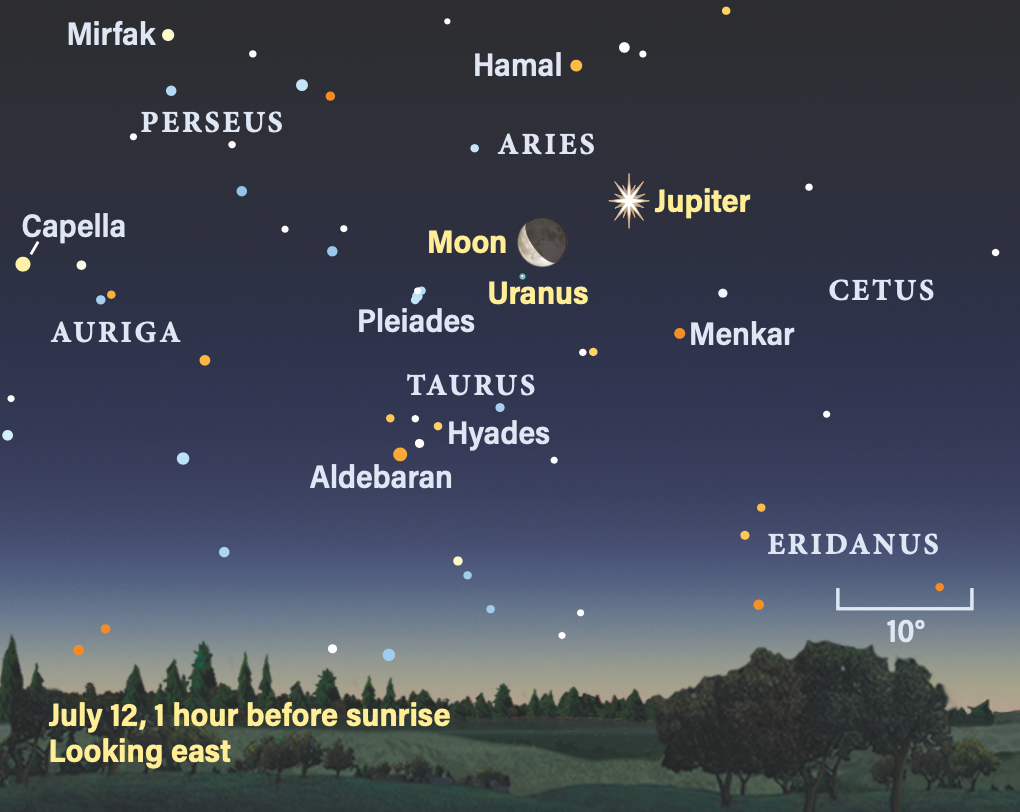
Uranus is located in Aries about 11° east of Jupiter and 9° southwest of the Pleiades (M45) in the predawn sky. By 4 a.m. you can find it low in the east just as Taurus has cleared the horizon. It’s an easy binocular object shining at magnitude 5.8 and due south of a small semicircular arc of 4th- and 5th-magnitude stars.
A crescent Moon joins the ice giant on the morning of July 12, when Uranus stands less than 4° due west of Luna in the growing twilight. It’s a pretty sight with Jupiter, M45, the Hyades, and Aldebaran joining in. Uranus is a challenging object to view with a telescope, since the low-altitude turbulence of our atmosphere often spoils the image.
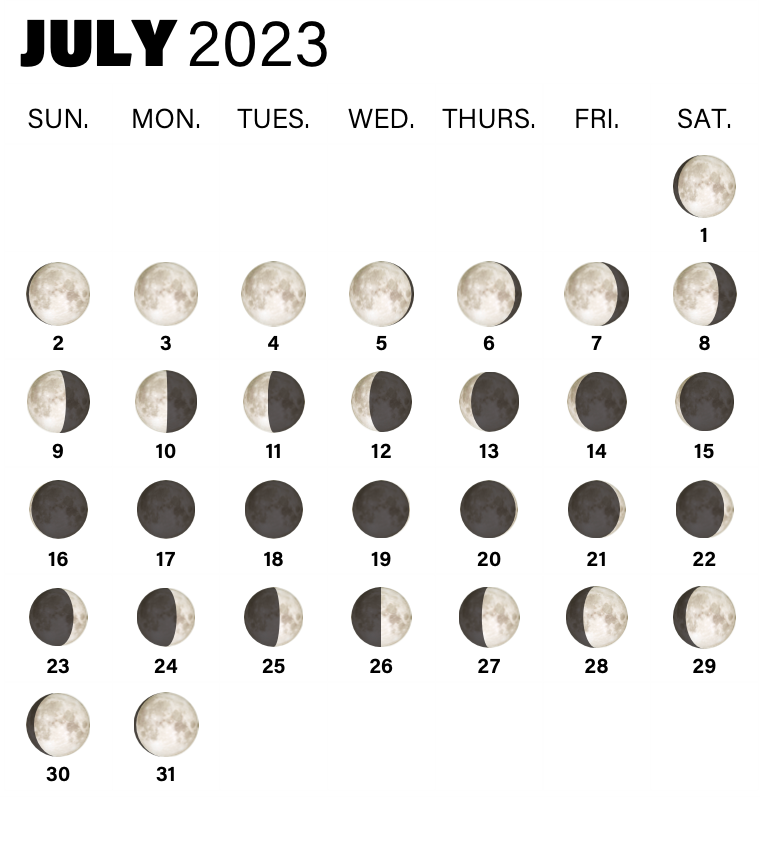
Rising Moon: Old lava, fresh craters
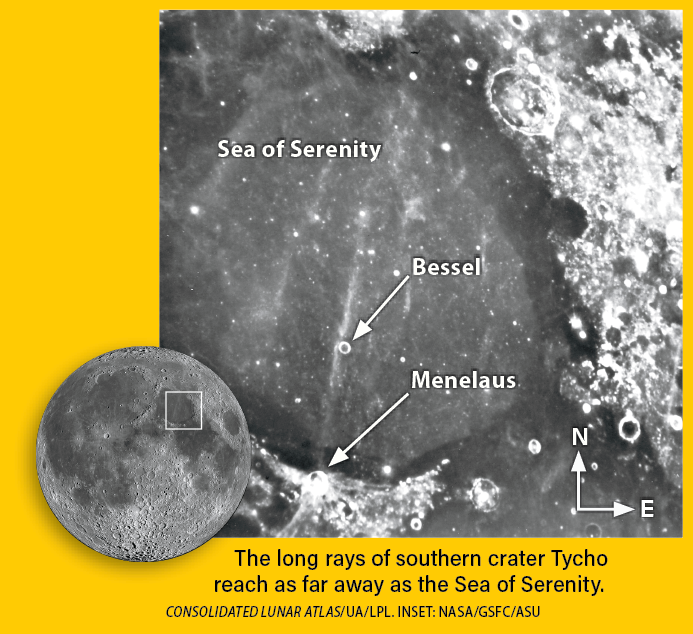
Consider doing a little sidewalk astronomy this month to show off Luna to those who’ve never seen it before. Whether it’s July’s first or last weekend, or while waiting for the fireworks to start, newcomers will gasp at the most impressive feature near Full Moon: Tycho and its magnificent ray system. The long lines were formed from the splash of a high-energy impact that excavated the lunar regolith and spread it outward.
Take note of the dark ring of melt products immediately surrounding the 53-mile-wide crater. Then let your eye naturally follow its longest ray to the northeast, where it splits the Sea of Serenity in near perfection.
The bright circular crater at the south edge of Serenity is the 15-mile-wide Menelaus. Its sharp edges and light-hued apron of debris are characteristics of relative youth, just like the smaller Bessel farther up the long stream. It seems as if Bessel disrupted the spray as it was spreading out, creating a sheltered spot on its north side, but it’s tough to be sure since other rays are broken without an immediate crater nearby.
Now look carefully at the surrounding lava. The darkest shade is the oldest, estimated at 3.8 billion years, while the lighter layer with a different composition that lies just to the north clocks in at closer to 3 billion. Can you see more white flecks (tiny impact craters) in the darker, older zone?
Astronomers have discovered that rays and aprons darken over time, due to the ceaseless solar wind and its energetic particles that microscopically sandblast the surface.
Meteor Watch: Summertime meteors
Summer is an ideal time to relax under a starry sky and watch for meteors. A number of minor showers are active in July. Visible meteor rates heavily depend on your location, the amount of street lighting, the moonlight, and the radiant’s altitude. Typically, rates increase in the early morning, when you’re on the leading hemisphere of Earth’s orbital path.
The Southern Delta Aquariids are active from July 12 through the first three weeks of August. The meteor stream may produce 25 meteors per hour at the peak on July 30 if the sky is clear and the radiant is overhead. The radiant is near 3rd-magnitude Skat in Aquarius. From North America, the radiant climbs to 25° high in the hour before dawn, reducing rates to under a dozen per hour. Try observing the few nights before the end of the month, because a bright Moon lingers all evening until the last few hours before dawn on the 30th and 31st.
Adding in any early Perseids could make the experience excellent for those venturing outside in the warm weather.
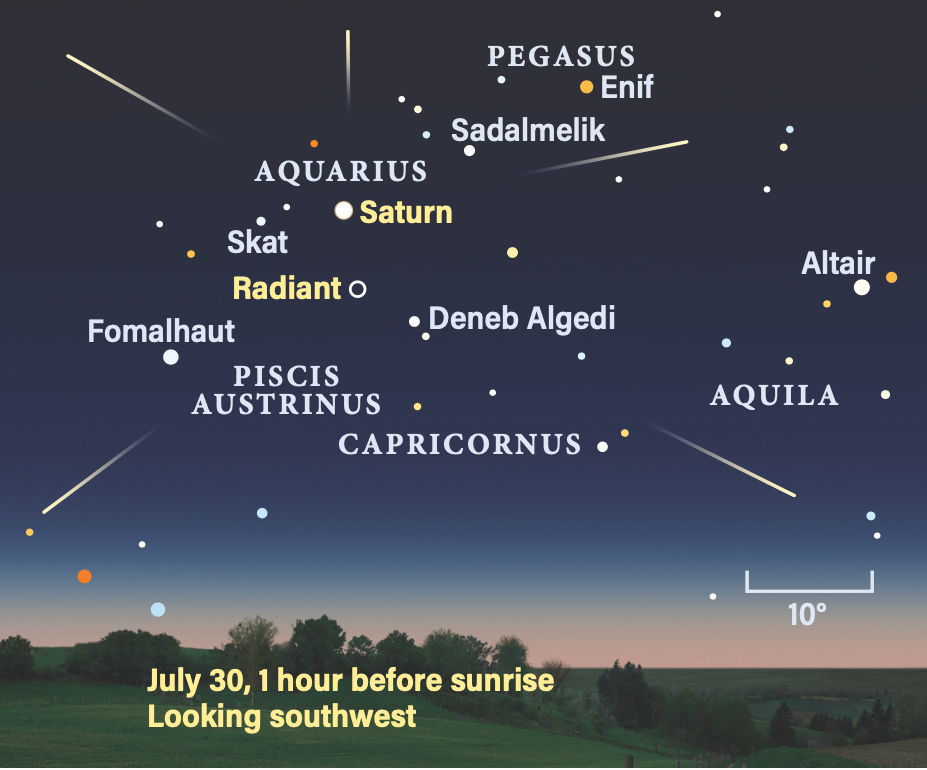
Comet Search: Prepare for a parade
The reward for observing faint comets is to have our eye and brain trained up to scout out subtle detail, shading, and form, ready to pick apart the brighter ones. And they’re coming. In August, 8th-magnitude C/2021 T4 (Lemmon) takes the lead, yielding to 7th-magnitude 103P/Hartley 2 in November, and possibly three binocular comets in the spring!
For now, Comet 237P/LINEAR takes a swipe at Aquila’s eastern wing, sliding from just below Eta (η) to Delta (δ) Aquilae at the Eagle’s heart. Unless it’s suddenly active, the distant comet is likely around 11th magnitude, a bit of a challenge for an 8-inch under decent country skies. As a warmup, go for 9th-magnitude globular star cluster NGC 6760, about 4° southwest of Delta.
Push the magnification to 150x or more. Both objects are fairly small and easily lost in the crowded Milky Way. Give yourself time to really adapt to the darker field; consider using a towel or your hoodie to shield yourself from the too-bright red of your tablet or chart light. Compare and contrast the non-stellar shapes and brightness profiles of both the comet and the cluster.
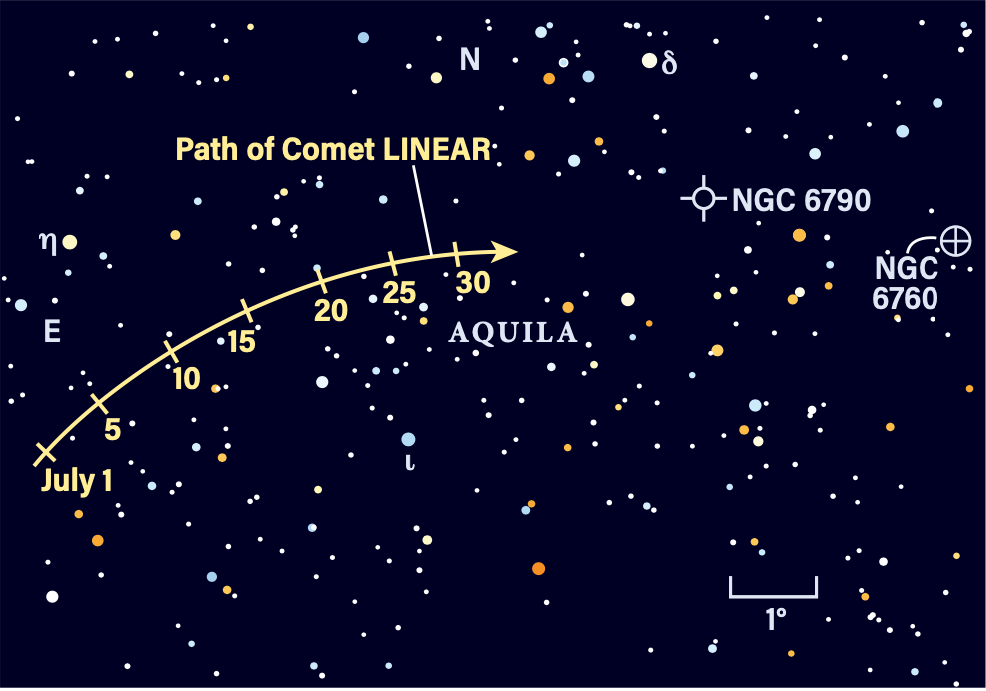
Locating Asteroids: Into the distance
1 Ceres hangs on for one last month, a decent telescopic target from the suburbs. It seems to drop into the Sun’s evening skyglow, but it’s actually Earth’s faster speed on our inside track that appears to shift the Sun between us.
Start at blue-white Spica in the southwest at dusk and jump halfway to magnitude 2.1 Denebola at the tail of Leo. Use the yellowish magnitude 3.4 Delta (δ) Virginis as your anchor. Drop in a wide-field eyepiece that gives a field of view about a degree across and leverage the easy patterns of bent sticks and pointy triangles to make your way westward to the dwarf planet’s location on the chart.
Glowing modestly at magnitude 8.8, Ceres will sometimes be the brightest dot in the field, though more often it will rank third or fourth. Avoid the 23rd, when the waxing Moon passes by. The 600-mile-wide world takes four nights to drift 1°, so you can easily make a sketch of five dots and come back another night to pick out which one has moved. Ceres is almost alone for the first five nights of the month, and again around the 12th. This far from the summer Milky Way, the background is much sparser, which should boost your confidence for a correct ID.
